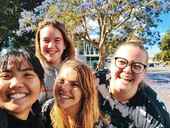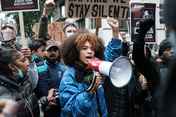Get specific about WHAT you are doing
A Community Child and Youth Well-being Survey is a powerful tool. It works best when it is supported by a thoughtful plan about how it will be introduced, completed and used afterward. The project calendar in this toolkit offers a basic framework and ideas for each stage of a plan that follows the data cycle.
Plans come in a variety of shapes and sizes. The plan’s basic structure starts with a clear definition of your goals and objectives (as stated in your project charter), describes strategies to achieve those objectives and then describes the tasks to be accomplished in varying levels of detail – in this case, for each stage of the data cycle. Once you have a general idea of the project’s overall timeline and key components, you can start assigning dates and people to specific deliverables. You can use Agile techniques, a Gantt chart, an Excel form or a program like Basecamp to generate the plan and stay organized. There are also a variety of digital platforms for shared documents, such as Box, Basecamp, Google Workspace and Microsoft Teams. Be sure to include associated expenses in the project budget.
Be prepared to revisit the plan frequently and allow for emergent ideas and opportunities as the project proceeds. The most useful plans are revised often and serve as “living documents” that evolve based on what you have learned and as new opportunities present themselves. Plans that are too rigid or static quickly become unhelpful as circumstances change. It is useful to note that the pilot of this survey was implemented during the height of the COVID-19 pandemic, which emerged after initial plans had been laid, requiring adaptations that ultimately strengthened community engagement.
.jpg)
See Appendix for advice about how to build a strategic plan.
One of the best ways to avoid problems is to prioritize communication throughout the stages of the survey. The more people feel up-to-date, involved and clear on the objectives, the less likely misunderstandings are to get in the way of the project moving ahead smoothly. You need to provide regular updates and repeat consistent messages with a frequency that may seem onerous when you are preoccupied with other matters. The best way to ensure this happens is to prepare a communications and media plan. The plan might include a number of components, such as:
- An exhaustive list of everyone you want to communicate with, either individually or en masse. You can start by identifying categories – like partners, stakeholders, media and the general public – and then fill in the details, including contact names and email addresses. You can start this list at the beginning of the planning stage as part of the initial engagement activity.
- An inventory of the communications media available to you and your partners, for example social media platforms, email and newsletter lists, school newsletters, places for posters such as libraries and community centres, and traditional local media including newspaper advertising, billboards, magazines and radio talk-shows.
- A list of materials to be prepared, with timelines, budgets and names of those responsible. The appendices contain many examples of these materials. For example:
- Key messages
- FAQ
- Backgrounder that could also be provided as a flyer or poster
- Presentation about the survey
- Press releases that announce the project, survey launch, promotion and results for distribution to local media
- Media contact list
- Website or social platform – for survey hosting or communicating with stakeholders
- Social media kit (i.e., posts, filters, frames) and video
- Summary for organizational newsletters
- Email messages for different audiences at different stages
- “Merch” for youth, such as branded shirts
- A communications toolkit for youth and partners containing the above materials and guidance for their use.
- A detailed plan of outreach and engagement activities that you will undertake with partner organizations and media, with accompanying timelines and the names of those responsible to make it happen.
- Measures of success. These are sometimes hard to project, but where metrics are available, it is useful to include them as targets (e.g., 500 social media shares or two on-air interviews).
When preparing the plan, consider key milestones along the data cycle, such as:
- Project launch. This is a great time to talk about why you are doing it and who is involved.
- Going “live” with the survey when it is ready to be communicated and completed. Promoting widespread access to the survey link and a clear purpose or impact message is key at this stage.
- Progress updates throughout the survey period, for example, “We’re halfway to our goal of 1,000 completed surveys” or “Only three days left to share your views.” “Here’s what young people are saying about bullying – what do you think?” If your research/data partner can update the project team weekly about survey responses, including demographic groups, you can adjust your outreach tactics and target them to reach certain areas or groups of young people.
- Close of the active survey phase. Share how many young people participated (e.g., “More than 1,000 young people from our community have made sure their voices will be heard”) and the next steps.
- Availability of preliminary results. Produce documents like a well-designed and communicated data report or series of “data briefs,” or organize interviews with young people, a press conference, etc.
- Actions and impacts. If you are organizing data “sense-making” and action-planning activities, targeted communication to participants will be a focus.
Like your project charter, your communications plan should be a living document that changes as frequently as circumstances do. Keep it in a central place so the whole team can see it and include progress updates as a key part of regular meetings.





































